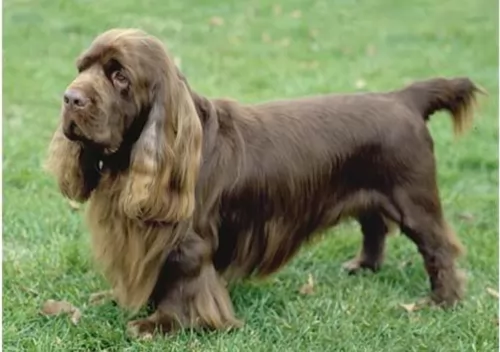 MyDogBreeds
MyDogBreedsSussex Spaniel is originated from United Kingdom but Other is originated from United States. Sussex Spaniel may grow 52 cm / 20 inches shorter than Other. Sussex Spaniel may weigh 97 kg / 213 pounds lesser than Other. Sussex Spaniel may live 5 years less than Other. Sussex Spaniel may have less litter size than Other. Sussex Spaniel requires Moderate maintenance. But Other requires Low maintenance
 The Sussex Spaniel comes from Sussex in southern England. The whole purpose of his development was for him to rush between reeds, causing birds to fly up and for their owners to then shoot them so that they could retrieve them.
The Sussex Spaniel comes from Sussex in southern England. The whole purpose of his development was for him to rush between reeds, causing birds to fly up and for their owners to then shoot them so that they could retrieve them.
His history dates back to the 19th century when breeding for the dog started. The first breed standard was also written during this time.
It was about in 1969 that some of these Sussex Spaniels were imported to the United States where they were referred to as a sporting breed. Today they are still a rare breed.
Dog lovers are thrilled because there is such diversity to choose from when looking for a pet.
There are so many other dogs that don’t have any particular breed name, and these can be tiny dogs or massive dogs that you would have to think twice about before buying one, as a large dog can eat you out of hearth and home.
All dogs, pedigreed or other, have descended from the wolf but it is unsure about when dogs were actually domesticated. One thing is sure, it is amazing to think that dogs descended from wolves but that you get so many varieties to day – different sizes, different coat colors and lengths, some have erect ears, others floppy, some are lean and mean and others muscular and heavily-set. They have all originated from different parts of the world.
There are well over 100 different pure dog breeds as well as plenty of other dogs. In fact you can create many different dogs by breeding certain of them to get the looks and characteristics you want.
 With his low, long body and short legs, this beautiful golden liver color spaniel has long, silky ears and a long, feathery tail.
With his low, long body and short legs, this beautiful golden liver color spaniel has long, silky ears and a long, feathery tail.
He is a moderate shedder. He is quite a distinctive looking dog with his silky coat and sombre expression. You’d descibe him as medium sized dog, standing at between 33 – 38cm in height and weighing 16 -20kg.
The Sussex Spaniel is more slow and sedate than the Cocker Spaniel but he still makes an excellent pet and companion.
He is strong and robust. He is clever too, but slightly stubborn, while also being clownish and entertaining. They’re the kind of dogs who bond strongly with their family and aren’t that enthusiastic with strangers.
They take a while to warm towards people they don’t know. He is steady, reliable and determined and makes a good watchdog. Because he is gentle and even tempered he makes an ideal pet for children and he is able to get on well with other dogs too.
It’s good to have them trained and socialized as they become even more amicable around other people and dogs they don’t know.
Dogs today come with so many looks. ‘Other’ dogs are vast and varied. They may be pedigreed dogs that are ‘off the radar’ or they may be among the many ‘cross-breed’ dogs there are.
You can get a tiny Chihuahua, measuring just 9cm in height, but you can also get a huge dog like the Great Dane that can stand at up to 90cm in height. It isn't however, a heavily built dog like the giant Newfoundland which can weigh up to 117 kg or so.
Some dogs are intelligent, others not so much. Others are social and others more reserved. Some won’t be able to tolerate being cooped up indoors and not being able to be outdoors involved in an activity, while others are more indoor dogs.
Some dog are friendly, others indifferent, some boisterous and sporty, others docile and lazy. There are so many other dogs that don’t make the pedigreed list, but they’re adored by their human family for being so utterly unique.
 He is a low drooling dog and he adapts easily to life with his human family, preferably in the countryside.
He is a low drooling dog and he adapts easily to life with his human family, preferably in the countryside.
He isn’t the most intelligent breed, but most people love him just like that because he’s eager to please and just wants to be your trusted, loyal pet and companion.
There are so many dogs, some are pedigree dogs and some aren’t. Some dogs are registered with kennel clubs and others aren’t.
Every dog has some amazing characteristics that make them so adorable. These kennel clubs divide dogs into categories such as Terriers, working dogs, herding dogs, toy breeds, hounds and so on. Pedigree breeds belong to these groups.
Other dogs are just as special, even if they don’t fall into the many dog breeds recognized by major kennel clubs.
There are so many other dog breeds, and if you want to bring some canine magic into your home and heart, apart from the very many expensive dog breeds out there, there are other dogs.
These are hybrids or true one-of-a-kind pavement specials that come at a fraction of the price but with the most amazing and wonderful characteristics you can imagine and which will make a most splendid pet.
 Your Sussex, like any other dog, is going to be prone to some diseases and conditions. If you are going for a puppy, always look for a reputable dog breeder, as this at least gives your dog a better chance of a healthy life.
Your Sussex, like any other dog, is going to be prone to some diseases and conditions. If you are going for a puppy, always look for a reputable dog breeder, as this at least gives your dog a better chance of a healthy life.
This is a congenital heart disease where blood doesn't flow properly and where the right side of the heart works harder and actually enlarges.
If the obstruction is severe, it can cause arrhythmia or congestive heart failure.
If the stenosis is mild, you may not even notice any conditions, but if it's severe, your pet may have difficulty with breathing, his stomach may be distended, and with strenuous exercise he could even collapse.
This is when a disc in the spine ruptures and pushes upward into the spinal cord. It can be an injury or an inherited condition.It is painful and will include anti-inflammatory medications and possibly surgery.
Other dogs are considered somewhat healthier than purebred dogs because they come from a broader gene pool. Nonetheless you still need to be aware of certain dog illnesses that your dog can develop -
This is a common ailment in dogs, and skin allergies can cause your dog a lot of discomfort and pain. They lick and lick and aggravate the situation. Sometimes fleas, chemicals and dog shampoos can aggravate the skin too. There are several things to look at – from making environmental changes to changing your dog’s food.
Cancer is common in dogs, just as in human beings, with there being a number of different cancers. Whenever you brush your dog, run your hands over him to check if there are any unusual lumps on him and have them examined if you do discover a lump.
Other dog illnesses to watch out for include bloat, ear and eye infections, cataracts, hip dysplasia and obesity, among others.
 Because of the long, silky hair, brushing your Sussex twice a week will be necessary to prevent matting from dirt adhering to the fur.
Because of the long, silky hair, brushing your Sussex twice a week will be necessary to prevent matting from dirt adhering to the fur.
The insides of those long floppy ears can be a breeding spot for bacteria as they don’t easily dry. When you brush him, check inside the ears to make sure they aren't red which could be a sign of ear infection.
Remember, if you don’t like to do all the grooming chores there are, a grooming parlour will do the chores for you. They cut your dog’s hair, check inside his ears, clean his teeth and trim his nails.
Every dog needs excellent food to be healthy. Many people feed their pets the wrong kinds of foods and then wonder why they have to fork up so much on vets fees.
If you feed your Sussex Spaniel one of the commercial manufactured foods, make sure its one of the good ones packed with vitamins and minerals. Tasty home-made food added to his kibble a couple of times a week can do him the world of good if its kept simple – no spicey, exotic foods that can upset the stomach.
Boiled chicken, brown rice or pasta and spinach, sweet potatoes and carrots all chopped up and mixed into the dry kibble once or twice a week will ensure a healthy, happy pet.
To avoid skin allergies and a dull coat, try and add in some raw meat occasionally. Always make sure he has access to fresh, cool water.
These dogs have been accustomed to a life of running in open spaces and they’re going to want lots of exercise. They love ball games and they love a walk in the countryside with lots of new scents to follow.
It’s why this dog isn’t suited to life in a small city property. He needs space and the outdoors to use up his energy.
Responsible dog owners know that their dogs require adequate food and water, lots of love and attention, exercise, a warm, dry bed, shelter from the elements when outdoors and medical attention when they’re sick.
One advantage with other dogs which aren’t pedigreed, is that by their very nature, they have good genetic diversity, and this means good overall health. Other dogs breeds are generally cheaper to buy and cheaper in terms of vet’s fees as they tend to be healthier.
Other dogs have a variety of different coat types, so whatever dog you have, you’ll need to be looking at brushing him, stripping him or having him professionally clipped. Whether erect or floppy ears, check inside for infection. The eyes will also need to be checked for infection and other eye ailments. All dogs will also have to have their nails clipped.
The size of all dogs, pedigree or other will determine the amount of food you give him. Big or small, pedigreed or other, every dog wants the same when it comes to diet. They want food which is nutritious, tasty and simple. They want a high quality commercially manufactured food high in minerals and vitamins.
They will benefit from some raw meat added into the kibble whenever its possible. They will also require some home-made food – simple, uncomplicated homemade food such as boiled chicken, brown rice or pasta and vegetables such as sweet potato, carrots and spinach. Such a diet will keep your pet free from digestive problems. Make sure he has a constant supply of cool, fresh water.
Exercise is important for every dog, but some dogs will require more exercise than others. Some dogs will be content with a walk every day while others will require far more – running beside you while you cycle, swimming, a run in the park, rope- and ball games and going with you on hikes.
Exercise is both entertaining for your dog and healthy too.